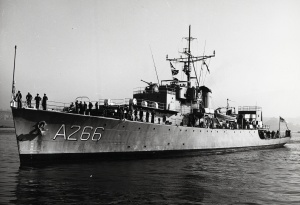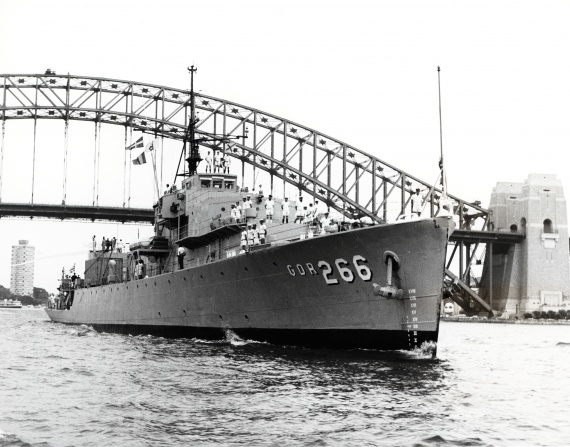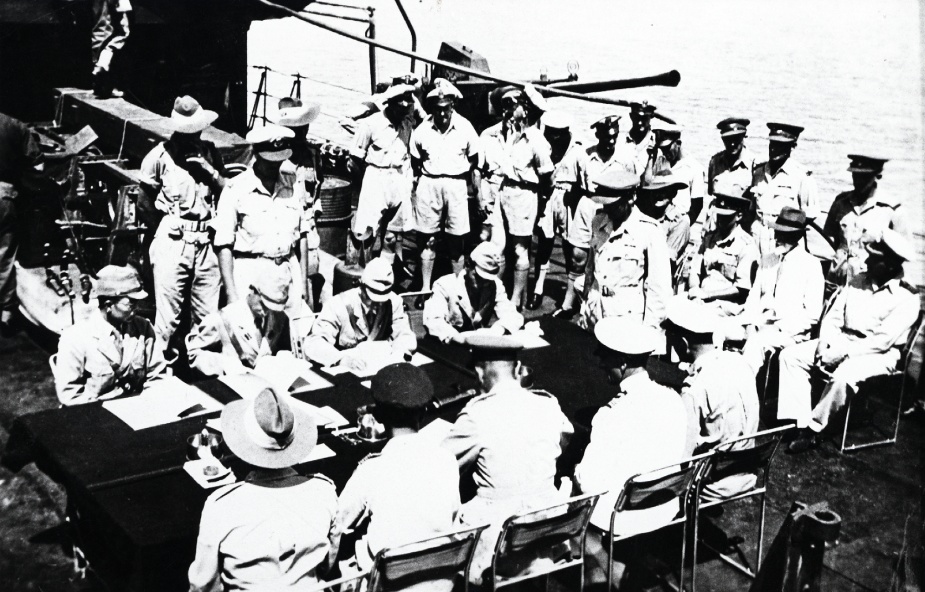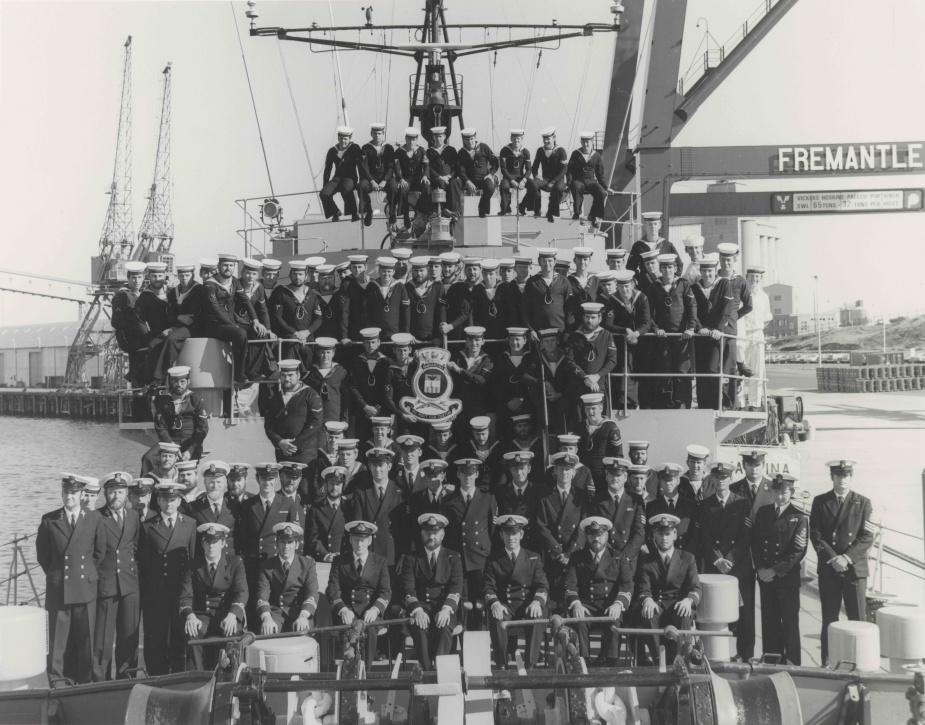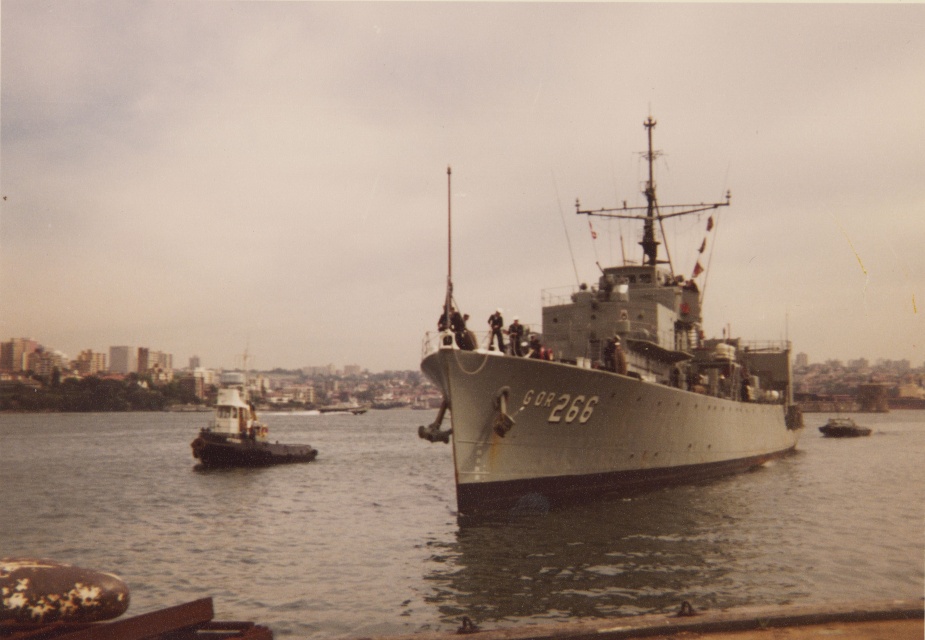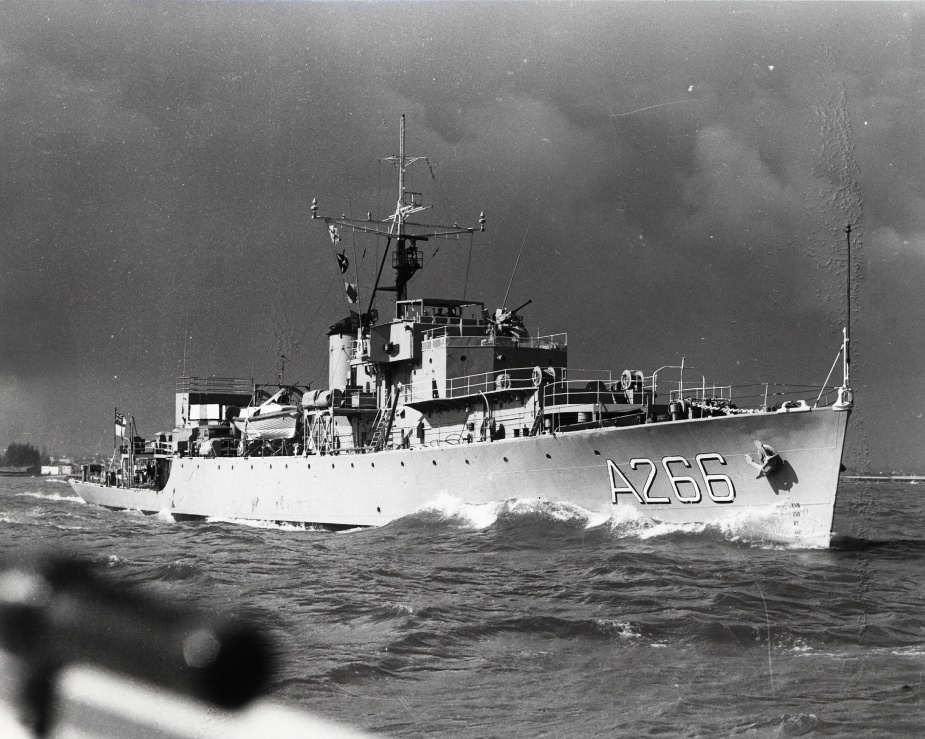HMAS Diamantina (I)
| Class |
River Class |
|---|---|
| Type |
Frigate/Oceanographic Research Ship |
| Pennant |
K377, A266 |
| Builder |
Walkers Ltd, Maryborough |
| Laid Down |
12 April 1943 |
| Launched |
6 April 1944 |
| Launched by |
Mrs Riordan, wife of the Chairman of Committees, House of Representatives and later Minister for the Navy |
| Commissioned |
27 April 1945 |
| Decommissioned |
29 February 1980 |
| Dimensions & Displacement | |
| Displacement |
|
| Length | 301 feet 4 inches |
| Beam | 36 feet 9 inches |
| Draught | 12 feet 6 inches |
| Performance | |
| Speed | 20 knots |
| Complement | |
| Crew | 140 |
| Propulsion | |
| Machinery | Triple expansion, 2 shafts |
| Horsepower | 5500 ihp |
| Armament | |
| Guns |
|
| Other Armament |
|
| Awards | |
| Battle Honours | PACIFIC 1941-45 |
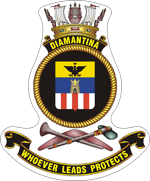
HMAS Diamantina was ordered as part of Australia's shipbuilding program during the Second World War. Twelve of these Australian built frigates were to enter service with the Royal Australian Navy. A further ten were ordered but cancelled as the war drew to a close.
Eight, HMA Ships Barcoo, Barwon, Burdekin, Diamantina, Gascoyne, Hawkesbury, Lachlan and Macquarie, were built to the British River Class design and Australia likewise named its frigates after Australian rivers. A further four, HMA Ships Condamine, Culgoa, Murchison and Shoalhaven, were also named after Australian rivers but were built to the design of the Royal Navy's Bay Class Frigates. These latter ships were generally known as Modified River Class Frigates although they are sometimes referred to as Bay Class.
Diamantina took her name from the river which rises in the region of the Kerby and McKinlay Ranges some 300 miles south of the Gulf of Carpentaria, and flows in a south westerly direction through Central Queensland.
Diamantina commissioned at Hervey Bay, Queensland, on 27 April 1945 under the command of Lieutenant Commander Maurice G Rose RANVR. She sailed the same day for Sydney where she remained until 24 May.
In June she completed her sea trials before proceeding to New Guinea, via Cairns, arriving at Madang on 23 June, and then sailed to Torokina in the Solomon Islands to await the arrival of the Governor-General, His Royal Highness The Duke of Gloucester, to provide transport to Saposa Island. This assignment was subsequently cancelled, but on 5 July Diamantina proceeded to Saposa with Lieutenant Generals Sturdee and Savige and several of their staff officers embarked.
On 7 July Diamantina carried out a bombardment of Sohana Island before leaving Saposa to return to Torokina. Departing Torokina on 17 July, Diamantina returned to the Saposa area and on 18 July took up a firing position off the east coast of Taiof Island for a second bombardment of Japanese batteries located on Sohana Island. A few minutes after the scheduled firing was completed, one Japanese heavy gun opened fire and a few shots fell harmlessly 400 yards astern.
The following day Diamantina again provided supporting fire for Australian troops ashore in Bougainville before proceeding to Manus where she arrived on 21 July to begin boiler cleaning.
On 7 August Diamantina returned to Torokina and the following day resumed bombardment of Japanese positions in the Solomon's, shelling the Bonis Peninsular and points along the south side of Buka Passage. On completion of what proved to be her last operational bombardment of the war she proceeded to Choiseul Bay and then to Lae, Langemak, and Madang which she reached on VJ Day (15 August).
In September 1945 Diamantina returned to the Solomon's and on 8 September embarked Lieutenant General Kanda and Vice Admiral Samejima and their staffs for passage to Torokina for the official surrender of Japanese forces in the Solomons.
On the same day Diamantina sailed for Nauru Island as Senior Naval Officer of the Nauru/Ocean Island Occupation Force. Following the official surrender of Nauru on board Diamantina she returned to Torokina on 19 September, departing on 22 September for the surrender of Ocean Island. En route on 26 September she called at Tarawa where she was welcomed as the first British warship to visit the Gilbert Islands since pre-war days. On 30 September she arrived at Ocean Island for the surrender and occupation which took place the following day.
Diamantina returned to Madang in New Guinea on 10 October and remained there for eighteen days before proceeding to Rabaul. In November she was engaged in towing a landing craft, salvaging stores abandoned on Emirau Island in the Admiralty islands and transporting a mine disposal party along the east coast of New Hanover.
In December, after transporting troops of the Australian 6th Division from Wewak to Madang, Diamantina sailed for Sydney carrying 78 passengers. She reached Sydney on 13 December 1945 after an absence of 181 days.
From March until May 1946, Diamantina was engaged in general duties based at Rabaul and Manus. On 31 May she departed Manus with ASR 912 in tow, taking 14 days to reach Sydney via the Trobriand Islands, Milne Bay, China Straits, Port Moresby, Bramble Bay and thence inside the Great Barrier Reef.
On 25 June 1946 Diamantina entered Port Phillip Bay for the first time and tied up at Williamstown. She paid off into Reserve on 9 August 1946.
Following a period of almost 13 years in Reserve, Diamantina recommissioned on 22 June 1959 as an Oceanographic Research Ship, under the command of Lieutenant Commander Bruce D Gordon RAN. She then commenced oceanographic survey duty, mainly off the Western Australian coast and in the Indian Ocean and Java Sea. She carried scientists from the Commonwealth Scientific and Industrial Research Organisation (CSIRO) during most of these surveys, but also assisted the Australian Army Survey team on the north west coast of Australia.
In February 1960, scientists aboard Diamantina discovered a fissure in the ocean floor west of Cape Leeuwin which dropped to depths of over 4000 fathoms. Now known as the Diamantina Trench, it is believed to be the deepest recorded water in the Indian Ocean.
Diamantina visited Cocos Island for the 46th anniversary of the HMAS Sydney/SMS Emden engagement. The Governor of Western Australia, Lieutenant General Sir Charles Gairdner KCMG KCVO KBE CB, who had travelled on the ship from Onslow in Western Australia, unveiled a commemorative plaque on 9 November.
Between survey cruises, Diamantina assisted in the Royal Australian Navy training programme by giving junior recruits from HMAS Leeuwin the opportunity to train at sea. During the Royal Visit to Western Australia in March 1963, she was escort to the Royal Yacht Britannia.
Diamantina's role as a survey and training ship continued into the 1970s. Among ports visited were Singapore, Colombo, Mauritius, Subic Bay, Hong Kong, Noumea and New Guinea. On 1 October 1971, officers and sailors from Diamantina participated in the Christmas Island Territory Day celebrations and in November of the same year the ship visited Jakarta. While in Jakarta problems of mutual interest were discussed with officers of the Indonesian Navy.
The visit to Christmas Island was one of many visits, as Diamantina made regular voyages to the island waters carrying out surveys and tests for the Royal Australian Navy Research Laboratories (RANRL).
In September 1978 the ship visited Funafuti Atoll in the Fijian islands for a survey and channel marking. A new precedent was set for Diamantina in February 1979 when a female scientist was embarked among the trials team and in May 1979 CSIRO scientists joined the ship for Global Weather Experiments.
Diamantina was showing definite signs of age when in July 1979 her Commanding Officer, Lieutenant Commander Burns, reported that he had been rudely awoken early one morning with 'a brew in the face.' One of the watch on deck had been sitting in the wheelhouse having a brew when he moved his chair. Unfortunately the chair landed on a wasted section of the deck immediately above the head of the Commanding Officer's bunk and the chair leg had come through the deck followed by the brew. A few days later a corrosion hole and a crack in the keel was discovered. While inspecting these problems a further hole was created when a diving knife was pushed through the keel.
On 9 October 1979 Diamantina sailed from Fremantle after a 20 year association with Western Australia and on 22 October she departed Sydney for her last hydrographic survey.
During her final cruise around Sydney Harbour on 23 November 1979, the ship flew her paying off pennant supported by six helium filled meteorological balloons. One hundred and thirty guests were embarked for the cruise including her original Commanding Officer, Commander Maurice Rose, and Scouts and Cubs from the Diamantina Scout Group (Canberra).
Diamantina paid off on 29 February 1980. As the last of the war time frigates still in service with the Royal Australian Navy, she had steamed 615,755 miles since first commissioning.
A number of organisations expressed interest in acquiring Diamantina after decommissioning. Finally, a decision was made to hand her over to the Queensland Maritime Museum Association (external link) to be permanently dry berthed as an exhibit in the old graving dock at Brisbane. The Association received financial assistance from the State Government and had previously acquired a number of items, including 4-inch guns, with the intention of restoring Diamantina to her wartime configuration. When the ship left Garden Island on 1 October 1980, she was flying the Queensland state flag on her port side yardarm. Diamantina is now on permanent display in Brisbane and restored to her World War II outfit of weapons.
Commanding Officers of HMAS Diamantina (I)
|
27 Apr 1945-22 Nov 1945
|
Lieutenant Commander MG Rose, RANVR
|
| 22 Nov 1945-17 Jul 1946 | Lieutenant Commander PJ Sullivan, RANR(S) |
| 22 Jun 1959-16 Mar 1960 | Lieutenant Commander BD Gordon, RAN |
| 16 Mar 1960-07 Sep 1961 | Lieutenant Commander GM Jude, RAN |
| 07 Sep 1961-07 Jun 1963 | Lieutenant Commander JG Yule, RAN |
| 07 Jun 1963-18 Jan 1964 | Lieutenant Commander RB Nunn, RAN |
| 18 Jan 1964-08 Jun 1965 | Lieutenant Commander PEM Holloway, RAN |
| 08 Jun 1965-28 Dec 1966 | Lieutenant Commander PG Duncan, RAN |
| 28 Dec 1966-06 Jan 1969 | Lieutenant Commander M Ward, RAN |
| 06 Jan 1969-16 Nov 1970 | Lieutenant Commander JE Buchanan, RAN |
| 16 Nov 1970-22 Jul 1972 | Lieutenant Commander MW Varley, RAN |
| 22 Jul 1972-03 Sep 1974 | Lieutenant Commander DM Davidson, RAN |
| 03 Sep 1974-14 Dec 1976 | Lieutenant Commander PG Brook, RAN |
| 14 Dec 1976-27 Oct 1978 | Lieutenant Commander PJ Cooke-Russell, RAN |
| 27 Oct 1978-14 Jan 1980 | Lieutenant Commander RJ Burns, GM, RAN |
| 14 Jan 1980-29 Feb 1980 | Lieutenant RA Diciunas, RAN |

